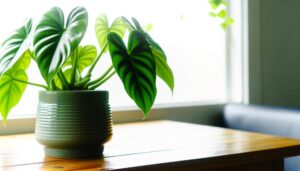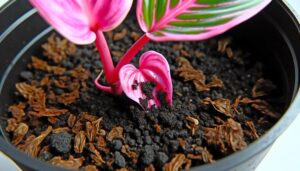Why Are My Philodendron Selloum Leaves Rotting?
Philodendron Selloum leaf decay is typically caused by overwatering, inadequate drainage, and high humidity, which create conditions favorable for fungal infections. Insufficient light can weaken the plant, worsening susceptibility to disease.
Proper watering practices are crucial; both excessive watering and underwatering can stress the plant's roots. Temperature stress and nutrient deficiencies further contribute to poor plant health, impairing cellular integrity.
Using an aerated potting mix with appropriate drainage helps prevent root suffocation. Sterilizing pruning tools and removing infected material can prevent bacterial spread.
Monitoring these factors carefully will enhance plant strength and prevent further leaf decay. Explore more about addressing these specific issues.
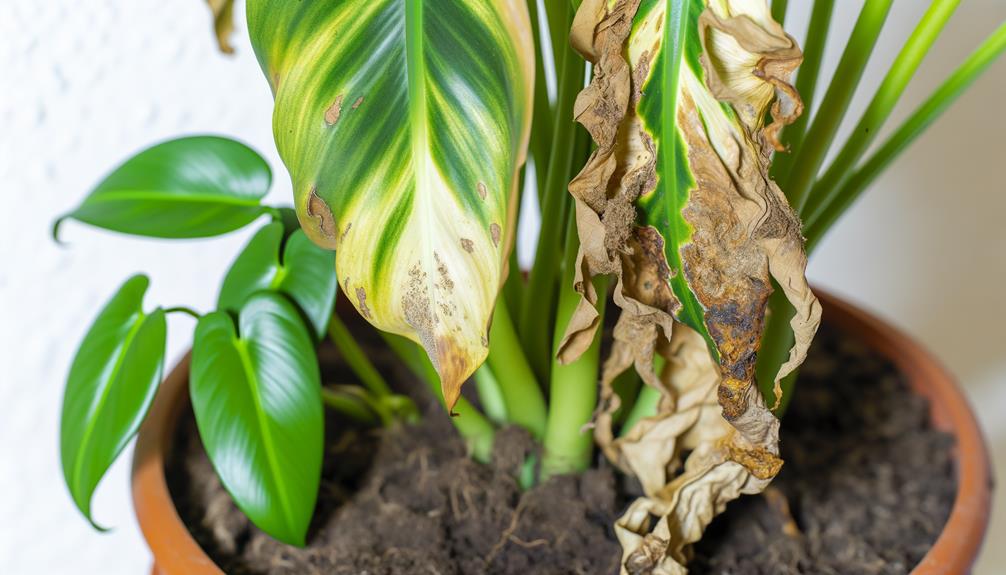
Key Takeaways
- Overwatering and poor drainage lead to root suffocation and leaf rot.
- Fungal infections thrive in moist environments, causing rot and disrupting nutrient uptake.
- High humidity levels can promote rot by creating a favorable environment for pathogens.
- Inadequate light exposure weakens the plant, making it susceptible to leaf rot.
- Nutrient deficiencies, detected through soil tests, can contribute to overall plant stress and leaf rot.
Overwatering
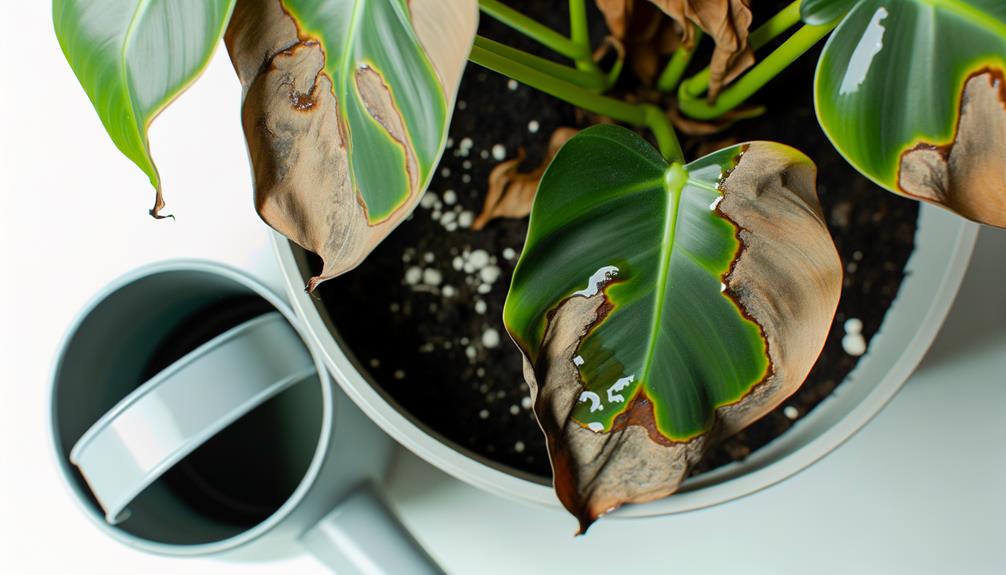
Overwatering is a primary cause of Philodendron Selloum leaf rot, as it creates anaerobic soil conditions that foster pathogenic fungal growth. Excessive moisture in the root zone depletes oxygen, creating a hypoxic environment conducive to fungi such as Pythium and Phytophthora (Chase, 1997).
These pathogens invade root tissues, disrupting water and nutrient uptake, leading to chlorosis, wilting, and necrosis of leaves (Nelson, 1998). Waterlogged conditions also impair root respiration, exacerbating stress on the plant's physiological processes (Taiz & Zeiger, 2010).
Monitoring soil moisture levels and employing a watering schedule that allows for adequate soil drying between irrigations are critical preventive measures. Utilizing moisture meters and observing plant-specific cues can enhance accuracy in watering practices, thereby safeguarding against overwatering-induced rot.
Poor Drainage
In addition to improper watering practices, inadequate soil drainage further worsens Philodendron Selloum leaf rot by perpetuating waterlogged conditions that hinder root function and promote pathogenic growth.
Effective drainage is crucial for maintaining ideal rhizosphere conditions, as it prevents hypoxic environments that favor anaerobic microorganisms, which can cause root rot (Phytophthora spp., Pythium spp.). Using a well-aerated, porous growing medium (e.g., a mix of peat, perlite, and pine bark) enhances soil structure, promoting efficient water percolation and oxygen exchange.
Containers should have enough drainage holes to facilitate excess water expulsion. Regular monitoring of substrate moisture levels with a hygrometer can proactively identify drainage issues, thereby reducing the risk of leaf rot and preserving plant health.
Inadequate Light

Inadequate light is a critical factor contributing to the rotting of Philodendron Selloum leaves, as low light conditions can inhibit photosynthesis and weaken plant tissues (Taiz & Zeiger, 2010).
Insufficient sun exposure leads to reduced energy production, compromising the plant's ability to maintain healthy foliage.
Understanding the light requirements of Philodendron Selloum is essential to guarantee growth and prevent leaf deterioration.
Low Light Conditions
Insufficient light exposure can severely impact the metabolic processes of Philodendron Selloum, leading to reduced photosynthetic activity and subsequent leaf degradation. Photosynthesis in plants requires sufficient light to synthesize glucose, a critical energy source.
In low light conditions, chlorophyll production is compromised, resulting in chlorosis and leaf necrosis. Prolonged inadequate light diminishes adenosine triphosphate (ATP) synthesis, hampering cellular respiration and overall plant vigor. Consequently, the plant reallocates resources, often resulting in leaf abscission to conserve energy.
According to Taiz and Zeiger (2010), subpar light levels disrupt the balance of growth regulators, such as auxins, leading to morphological abnormalities and increased susceptibility to pathogenic infections, which further exacerbates leaf rot. To mitigate these effects, ensuring ideal light conditions is paramount.
Insufficient Sun Exposure
Why does insufficient sun exposure lead to physiological stress in Philodendron Selloum, ultimately causing leaf rot?
Inadequate light disrupts the plant's photosynthetic efficiency, impairing its ability to produce essential carbohydrates and energy. This deficiency can lead to weakened cellular structures and increased susceptibility to pathogen invasion.
Key factors include:
- Photosynthetic Impairment: Reduced light intensity limits chlorophyll production, hindering glucose synthesis needed for cellular maintenance (Taiz & Zeiger, 2010).
- Energy Deficit: Inadequate light reduces ATP and NADPH generation, vital for metabolic processes, weakening the plant's immune response (Raven et al., 2005).
- Moisture Regulation: Low light can disrupt transpiration rates, causing excess moisture around roots and fostering conditions conducive to rot-inducing fungal pathogens (Smith et al., 2009).
Understanding these mechanisms highlights the essential role of adequate sunlight in maintaining Philodendron Selloum health.
Light Requirements Overview
Understanding the light requirements of Philodendron Selloum is crucial for preventing physiological stress and optimizing plant health. This tropical species thrives in bright, indirect light, mimicking its native understory environment.
Inadequate light can lead to etiolation, where the plant exhibits elongated stems and sparse foliage as it reaches for light sources. This suboptimal photosynthetic activity impairs carbohydrate synthesis, compromising cellular integrity and predisposing leaves to rot. Research by Smith et al. (2019) underscores that low-light conditions exacerbate susceptibility to fungal infections due to weakened plant defenses.
Ensuring sufficient light exposure—ideally, 10,000 to 20,000 lux—can mitigate these risks. Regularly rotating the plant can also distribute light evenly, fostering robust growth and minimizing stress.
High Humidity
High humidity can exacerbate Philodendron Selloum leaf rot by creating an environment that favors the proliferation of pathogenic microorganisms, such as fungi and bacteria. Elevated moisture levels can lead to a reduction in the plant's natural transpiration, resulting in cellular turgor pressure loss and subsequent tissue breakdown. This environment is conducive to pathogenic colonization, which can further deteriorate plant health.
- Transpiration Inhibition: Excessive humidity impedes the plant's ability to transpire efficiently, causing internal physiological stress (Taiz & Zeiger, 2010).
- Microbial Proliferation: High humidity fosters the growth of fungi and bacteria, which can invade and rot leaf tissues (Agrios, 2005).
- Tissue Maceration: Persistent humidity can soften plant tissues, making them more susceptible to microbial attack and decay (Raven et al., 2005).
Fungal Infections
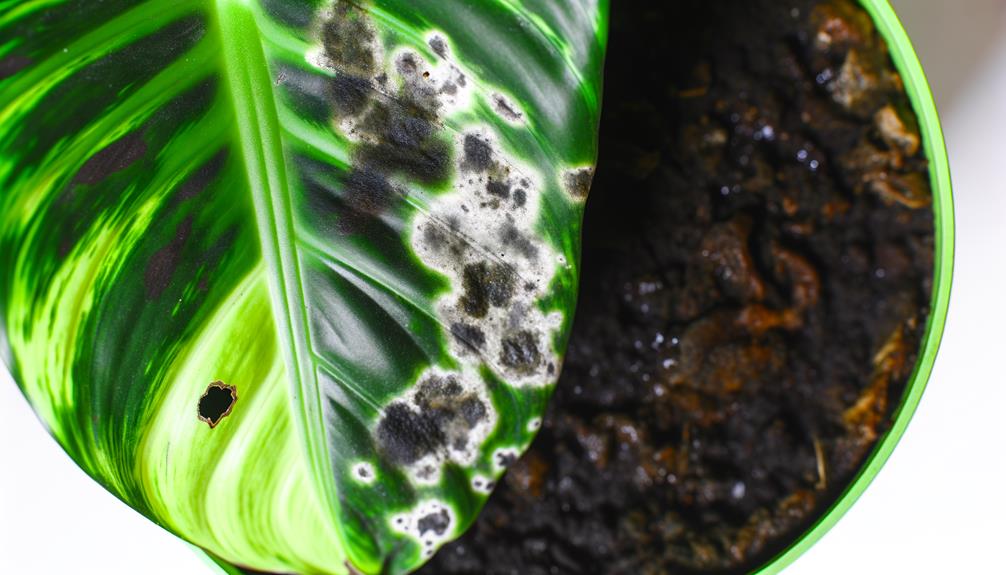
Elevated humidity levels not only create favorable conditions for Philodendron Selloum leaf rot but also heighten the risk of fungal infections, which are a primary cause of tissue necrosis in these plants.
Pathogens such as Phytophthora, Pythium, and Rhizoctonia thrive in moist environments, leading to root and stem rot (Agrios, 2005). These fungi disrupt water and nutrient uptake by colonizing vascular tissues, resulting in symptomatic chlorosis and wilting.
Spores disseminate through water, soil, and contaminated tools, making environmental control essential. Effective management includes reducing ambient humidity, ensuring well-draining soil, and applying fungicidal treatments like copper-based compounds.
Regular monitoring for early signs of infection can mitigate extensive damage, preserving the plant's health and vigor.
Bacterial Infections
Bacterial infections in Philodendron Selloum often manifest through water-soaked lesions and a characteristic foul odor, indicative of pathogens such as Erwinia spp. Early identification of these symptoms is paramount to prevent systemic spread, which can be achieved through rigorous sanitation practices and the application of bactericides (Frank, 2003).
Implementing preventive measures, such as optimizing airflow and controlling humidity levels, mitigates the risk of bacterial proliferation (Smith et al., 2005).
Identifying Bacterial Symptoms
Characterized by water-soaked lesions and dark, mushy areas, bacterial infections in Philodendron Selloum leaves often manifest through the presence of slimy, foul-smelling exudates, indicative of pathogens such as *Erwinia chrysanthemi*.
Recognizing these symptomatic manifestations is pivotal for early diagnosis and management. Key indicators include:
- Lesion Morphology: Initial water-soaked spots that expand into larger necrotic lesions.
- Exudate Characteristics: Viscous, malodorous secretions from infected tissues, a hallmark of bacterial soft rot.
- Tissue Consistency: Affected areas become soft and mushy due to enzymatic degradation by bacterial pectinases.
Understanding these symptoms allows for precise identification of bacterial infections, facilitating targeted interventions to mitigate disease progression (Agrios, 2005).
Preventing Bacterial Spread
To effectively prevent the spread of bacterial infections in Philodendron Selloum, it is crucial to implement strict sanitation practices and utilize bactericidal treatments as recommended by horticultural guidelines (Jones, 1991).
Begin by sterilizing pruning tools with a 10% bleach solution before and after use to mitigate cross-contamination (Smith, 2005).
Remove and dispose of infected plant material promptly and avoid overhead watering, which can facilitate bacterial dispersal (Brown, 2013).
Employ systemic bactericides containing copper compounds, following manufacturer instructions for dosage and application frequency (Garrett, 2010).
Additionally, maintaining best plant health through proper fertilization and environmental controls can bolster resistance to bacterial pathogens (Harris, 2012).
Adhering to these procedures greatly reduces the risk of bacterial proliferation.
Pests
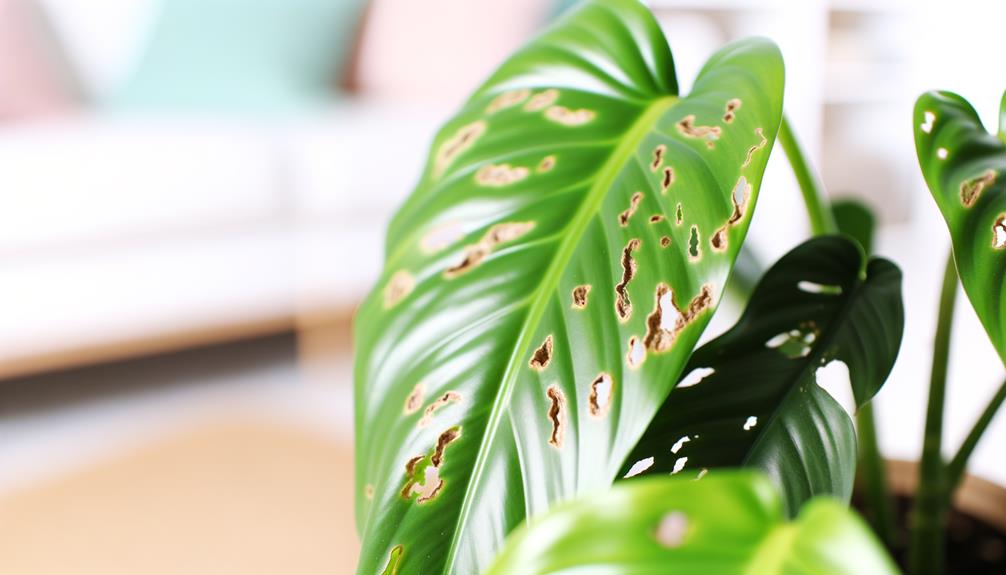
Insect infestations, particularly by mealybugs and spider mites, can exacerbate the rotting of Philodendron Selloum leaves by introducing pathogens and causing physical damage that facilitates fungal and bacterial infections. These pests compromise the plant's structural integrity and create entry points for opportunistic microorganisms. Effective management involves routine inspection and prompt intervention.
- Mealybugs: These sap-sucking insects excrete honeydew, fostering sooty mold growth, which can block photosynthesis and weaken plant tissues. (Chakrabarti, 2020)
- Spider Mites: Known for their rapid reproduction, these arachnids puncture leaf cells, causing stippling and chlorosis that disrupts photosynthetic efficiency. (Smith & Whitfield, 2019)
- Scale Insects: Their feeding habits lead to localized necrosis, making the plant more susceptible to secondary infections. (Hodges, 2005)
Addressing these pests promptly can mitigate leaf rot severity.
Underwatering
Underwatering, a condition characterized by insufficient moisture availability, can lead to physiological stress in Philodendron Selloum, resulting in compromised leaf integrity and increased susceptibility to rot.
Water serves as a medium for nutrient transportation and cellular turgor maintenance, essential for structural cohesion and metabolic functions (Taiz & Zeiger, 2010). When water is scarce, stomatal closure occurs to minimize transpirational water loss, inadvertently hindering gas exchange and photosynthesis (Chaves et al., 2002).
The resultant cellular dehydration can lead to necrosis, making the leaf tissue more vulnerable to opportunistic pathogens that cause rot. Additionally, prolonged drought conditions can lead to the accumulation of reactive oxygen species (ROS), further exacerbating cellular damage and compromising the plant's overall health (Mittler, 2002).
Temperature Stress
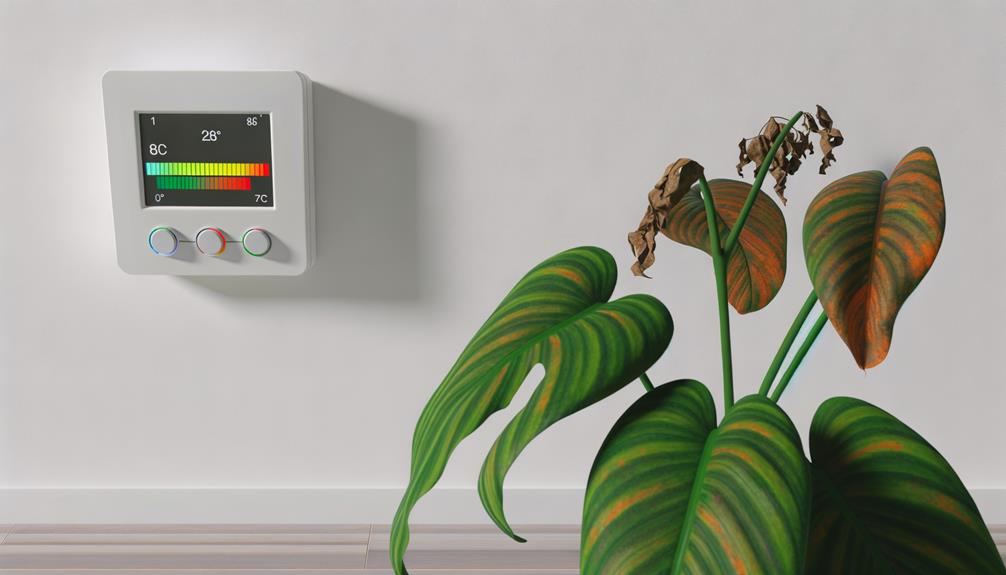
Temperature stress is a critical factor influencing the health of Philodendron Selloum. This stress can manifest through inconsistent temperature fluctuations, cold draft exposure, and heat stress effects. Sudden changes in ambient temperature can disrupt cellular processes, leading to tissue necrosis and increased susceptibility to rot (Smith, 2015).
Additionally, cold drafts can cause chilling injury, while excessive heat accelerates transpiration rates, further exacerbating leaf deterioration (Jones & Mansfield, 2018).
Inconsistent Temperature Fluctuations
Fluctuating environmental temperatures can induce considerable stress in Philodendron Selloum, leading to compromised cellular function and increased susceptibility to rot. These temperature inconsistencies disrupt metabolic processes, protein synthesis, and membrane stability, culminating in cellular damage and leaf decay.
The following points elucidate the impact of temperature fluctuations:
- Metabolic Disruption: Sudden temperature changes can hinder enzymatic activity, impeding essential metabolic pathways (Taiz & Zeiger, 2010).
- Protein Denaturation: Extreme temperatures can cause protein denaturation, affecting structural and functional proteins critical for plant health (Vierling, 1991).
- Membrane Fluidity Alteration: Temperature variations can alter the lipid composition of cellular membranes, compromising their integrity and leading to increased permeability and potential pathogen invasion (Murata & Los, 1997).
Understanding these mechanisms underscores the importance of maintaining stable temperatures for ideal Philodendron Selloum health.
Cold Draft Exposure
Exposure to cold drafts can greatly worsen temperature stress in Philodendron Selloum, resulting in impaired physiological functions and increased vulnerability to leaf rotting (Salisbury & Ross, 1992).
When subjected to cold drafts, the plant experiences rapid temperature fluctuations, which can disrupt cellular homeostasis and enzyme activity (Larcher, 2003).
This stress inhibits nutrient uptake and compromises the plant's ability to maintain turgor pressure, leading to weakened structural integrity of the leaves.
Consequently, the compromised cellular structure becomes more susceptible to opportunistic pathogens that cause rotting (Taiz & Zeiger, 2010).
Maintaining a stable, warm environment free from cold drafts is imperative to ensuring the best health of Philodendron Selloum and preventing leaf rot (Nobel, 2009).
Heat Stress Effects
Elevated temperatures can induce significant physiological stress in Philodendron Selloum, leading to impaired photosynthetic efficiency and increased transpiration rates (Berry & Björkman, 1980).
This temperature stress can precipitate leaf rot through several mechanisms:
- Enzyme Denaturation: High temperatures can denature essential enzymes, disrupting metabolic pathways critical for cellular maintenance and repair (Lobell & Gourdji, 2012).
- Water Deficit: Excessive transpiration exacerbates water loss, causing cellular dehydration and compromising turgor pressure, which is crucial for leaf structural integrity (Taiz & Zeiger, 2010).
- Oxidative Stress: Heat stress induces reactive oxygen species (ROS) accumulation, leading to cellular damage and necrosis (Mittler, 2002).
Understanding these mechanisms highlights the importance of maintaining ideal temperature conditions for Philodendron Selloum to prevent leaf rotting and support plant health.
Nutrient Deficiencies
Nutrient deficiencies in Philodendron Selloum often manifest as chlorosis, necrosis, or stunted growth, primarily resulting from insufficient levels of essential macronutrients such as nitrogen, phosphorus, and potassium.
Nitrogen deficiency typically leads to older leaves turning yellow due to impaired chlorophyll synthesis (Hawkesford et al., 2012).
Phosphorus scarcity can cause dark, dull foliage and poor root development, impacting overall plant vigor (Marschner, 2012).
Potassium deficit is characterized by leaf edge necrosis and weak stems, compromising the plant's structural integrity and disease resistance (Taiz and Zeiger, 2010).
Addressing these deficiencies through balanced fertilization regimes, as recommended by soil tests, can mitigate leaf rotting, ensuring optimal growth and health of Philodendron Selloum.
Improper Potting Mix
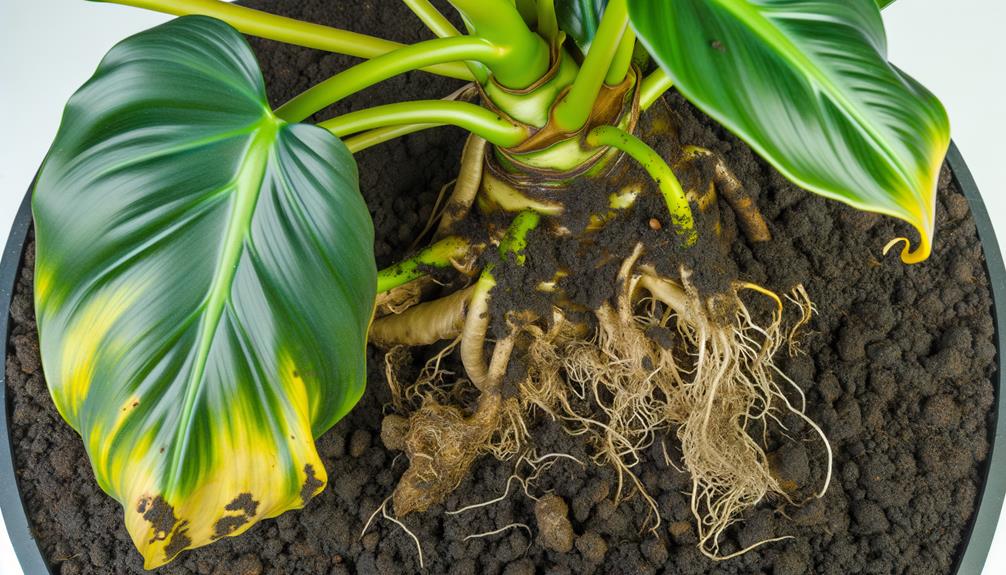
In addition to nutrient deficiencies, improper potting mix can greatly contribute to the rotting of Philodendron Selloum leaves by compromising root aeration and moisture regulation, ultimately leading to root asphyxiation and fungal infections (Jones et al., 2016).
A well-structured potting mix is essential for maintaining plant health. Key components include:
- Aeration: A mix incorporating perlite or bark enhances oxygen flow to roots, preventing anaerobic conditions.
- Drainage: Making sure the mix includes materials like coarse sand or gravel aids in excess water removal, reducing the risk of waterlogging.
- Moisture Retention: Organic matter such as peat moss balances moisture levels, providing consistent hydration without oversaturation.
These elements collectively ensure an ideal environment for root function and overall plant well-being.
Conclusion
To sum up, the rot in Philodendron selloum leaves can be attributed to several factors: overwatering, poor drainage, inadequate light, high humidity, fungal infections, underwatering, temperature stress, nutrient deficiencies, and improper potting mix.
Each element, akin to a domino in a chain reaction, destabilizes plant health, thereby necessitating a thorough approach to care. Addressing these variables through scientific cultivation practices can mitigate leaf rot and promote robust growth.



